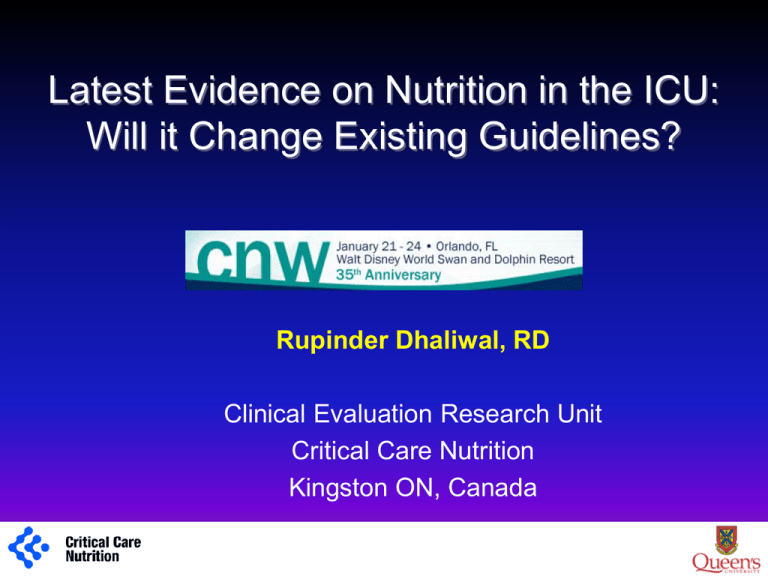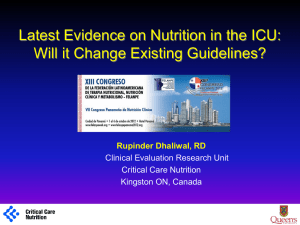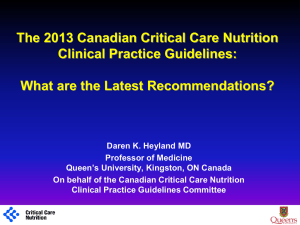
Latest Evidence on Nutrition in the ICU:
Will it Change Existing Guidelines?
Rupinder Dhaliwal, RD
Clinical Evaluation Research Unit
Critical Care Nutrition
Kingston ON, Canada
1
Outline of Session
New RCTs in area of critical care nutrition (adult)
Updated analyses of Canadian Guidelines
Impact on evidentiary basis
1
Conflict of interest
Co-author of Canadian Clinical Practice Guidelines
1
Canadian CPGs
JPEN 2003
1980-2003
n > 200 RCTs
34 topics
17 recommendations
1
2005 update
2007 update
2009 update
www.criticalcarenutrition.com
Development of Guidelines
evidence
+ integration of values
practice
guidelines
1
Validity
Homogeneity
Safety
Feasibility
Cost
Inclusion Criteria
Updated to 2011
• Randomized controlled trials
• Critically ill patients (not elective surgery)
• Clinical Outcomes
• EMBASE, Medline, Cinhal, reference lists
New RCTs* per Topic (n =51)
Topic
# RCTs 2009
# new RCTs
Early vs. delayed
14
2
Target dose EN
2
2
Fish Oils/Borage Oils
5
4
Protein/peptides
4
1
Fibre
6
1
Small Bowel vs. Feeding
11
5
Protocols/GRVs
3
2
Probiotics
12
7
Supplemental PN
5
5
PN Type of lipids
5
4
PN Glutamine
17
8
Antioxidants
16
5
PN Selenium
11
5
* from 2009-2011
Probiotics
1
Probiotics
2009 Recommendation
There are insufficient data to make a recommendation
on the use of Prebiotics/Probiotics/Synbiotics in critically
ill patients
New RCTs = 7
1
Knight 2009
Barraud 2010
Morrow 2010
Frohmader 2010
Ferrie 2011
Sharma 2011
Tan 2011
Probiotics: effect on infections (n =11)
Lower quality studies > effect
vs. higher quality studies
p = 0.03
2009 update : RR 0.89 [0.68, 1.17] p = 0.4
Petrof et al in submission Critical Care 2012
Probiotics: effect on VAP (n = 7)
Petrof et al in submission Critical Care 2012
Probiotics: effect on ICU mortality (n = 6)
2009 update : RR 0.74 [0.50, 1.09] p = 0.12
Petrof et al in submission Critical Care 2012
Probiotics with new RCTs
stronger signal for reduction in infections
– higher quality studies do NOT show a reduction in
infections
significant reduction in VAP
still trend towards reduction in ICU mortality
1
Arginine
2009 Recommendation
Based on 22 studies, we recommend arginine and other
select nutrients not be used for critically ill patients
no effect on mortality
no effect on infections
1
significant reduction in infections p <0.0001
significant shorter HLOS p <0.0001
Drover et al Am Coll Surg 2011
Enteral Fish Oils* ?
(Product enhanced with fish oils +borage oils + antioxidants)*
1
Enteral Fish Oils
(Product enhanced with fish oils +borage oils + antioxidants)
2009 Recommendation
Based on 5 studies, we recommend the use of
enteral formula with fish oils, borage oils, and
antioxidants in patients with ALI/ARDS
New RCTs = 4
Multicenter, RCT, 14 ICUs in Brazil
N = 200, early stages of sepsis (no organ failures; within 36 hrs from onset
of sepsis).
Fish oil/borage oil/antioxidant vs. standard polymeric X 7 days
PREVENTION
Outcomes:
VS. TREATMENT
• Evolution to more severe forms of sepsis (severe sepsis or septic
shock
• 28 day all-cause mortality, organ failure development,
hyper/hypoglycemic events, insulin use, hospital stay, ICU stay
Pontes-Arruda Crit Care 2011;15:R144
11 Spanish ICUs
89 patients with diagnosis of Sepsis on admission
Randomized to:
• Fish Oil/Borage Oil formula OR
• Standard polymeric formula
Outcomes: new organ dysfunction
Grau-Carmona Clin Nutr 2011
Clinical Outcomes
Fish Oils: Trend towards lower SOFA scores (NS)
Grau-Carmona Clin Nutr 2011
NIH
NHLBI
Timing of Feeding
S
U
P
P
L
E
M
E
N
T
“Early
Full”
N-3 + GLA +
Antioxidants
(Module delivered
as bolus bid)
Control
Standard EN
(480 cal/ 20 g pro)
Fast ramp up
“Early
Trophic”
(10 ml/hr)
n = 250
n = 250
n = 250
n = 250
OMEGA: 60-Day Mortality
P=0.05
P=0.14
Rice et al JAMA Oct 2011
89 patients from 5 centres in US
Mechanically ventilated patients with Acute lung injury (ALI)
Randomized to (separate
EN):
Fishfrom
Oils
ONLY
• BOLUS fish oils 7.5 mls q 6 hrs, 9.75g EPA & 6.75 gm DHA/day
Bolus
OR
• placebo i.e. normal
saline X 14
days EN
Separate
from
EN or PN as per MDs discretion
Stapleton CCM 2011
Clinical Outcomes
Stapleton CCM 2011
……..Because of different study design, difficult to
combine with other studies of continuous
administration in moderately well fed patients…..
Cook, Heyland JAMA Oct 2011
Fish Oils: Effect on mortality (n = 7)
INTERSEPT data not included
No effect , statistical heterogeneity!
2009: RR 0.67, 95% CI 0.51, 0.97, p = 0.003
Fish oils: effect on mortality removing
bolus RCTs
1
EN fish oils: with new RCTs
Effect on mortality disappears when bolus studies are
included
clinical heterogeneity
-studies using bolus fish oils are methodologically different
- one RCT does not have GLA, antioxidants
statistical heterogeneity
with the addition of the bolus studies
Parenteral Fish Oils
1
Type of Lipids (PN)
2009 Recommendation
There are insufficient data to make a recommendation
on the type of lipids to be used in critically ill patients
receiving parenteral nutrition
New RCTs = 4
Fish Oil containing vs LCT/MCT or LCT
Olive Oil containing vs LCT/MCT or LCT
LCT + MCT vs LCT
LCT vs LCT
N = 25 septic pts
PN + Fish Oil
vs. PN + soybean oil
p = 0.004
Barbosa Crit Care 2010
N = 56 patients with SAP, China
PN with Fish Oils (+ LCT) vs PN (LCT) X 5 days
Fish Oils improved plasma IL-10 levels, decreased HLA= anti-inflammatory
No effect on clinical outcomes
Wang Inflammation 2009
N= 28 patients with Severe Sepsis, Taiwan
Supplementation with Fish Oils 100 mls/day X 5 d vs. Placebo (saline)
Reduction in APACHE 3 score:
• improved more in Fish oil group Days 3, 5 & 7 (p =0.03-0.004)
Khor Asian J Surg 2011
Procalcitonin levels
Procalcitonin levels are a
marker of inflammatory
response
No difference in hospital
or length of stay between
the groups
Khor Asian J Surg 2011
N = 61 patients with ARDS, India
Supplementation with Fish Oils + EN vs. EN alone X 14 days
Oxygenation
•P/F ratio: no differences
• worsening in P/F ratio: higher in control group (p=0.0004)
Mortality: trend towards lower in Fish Oil group (p = 0.10)
Ventilation, ICU LOS: no difference
Gupta Ind J Crit Care Med 2011
Fish Oil vs LCT + MCT: Updated Effect on
mortality (n = 7)
2009: RR 0.76, [0.46, 1.26], p = 0.29
1
Fish Oil vs LCT or LCT + MCT: Effect on infections
(n = 3)
2009: RR 0.77 [0.39, 1.49], p = 0.43
1
PN lipids: with new RCTs
Other lipids: no changes
fish oils: studies with different designs
2 studies of lipids in PN
2 studies of supplemental fish oils
fish oils: signal for reduction in mortality
fish oils: still no effect on infections
1
Glutamine supplementation?
1
EN Glutamine
2009 Recommendation
Based on 2 level 1 and 7 level 2 studies, enteral glutamine
should be considered in burn and trauma patients. There
are insufficient data to support the routine use of enteral
glutamine in other critically ill patients
New RCTs = 2
Chinese
RCTs
PN Glutamine
2009 Recommendation
Based on 17 studies, when parenteral nutrition is prescribed to critically
ill patients, parenteral supplementation with glutamine, where available,
is strongly recommended. There are insufficient data to generate
recommendations for intravenous glutamine in critically ill patients
receiving enteral nutrition
New RCTs = 5
Grau 2011
Andrews 2011
Wernerman 2011
Eroglu 2009
Perez Barcena 2010
+ possibly 3 Chinese RCTs
• 10 centres in Scotland
• 502 Patients expected to be in ICU for at least 48h and required PN
meet at least half their requirements
• Randomized 2.6 days after admission to ICU
• Trial PN isocaloric and isonitrogenous, given for up to 7 days unless
died or stopped PN
» Glutamine 20g/d
» Selenium 500μg/d
» Both
» Neither
• Median duration of study PN was 4-5 days
Andrews BMJ 2011:342
The SIGNET Trial – RESULTS
Effect of Glutamine
Mortality
No significant differences
Confirmed infections within 14 days
No significant differences
The SIGNET Trial – Questions!
• Right patient population?
– Only about half getting PN at time of randomization
• Timing of intervention?
– Started too late (2.6 days plus time to get PN running)
• Inadequate exposure to intervention?
– Too small of dose
– Too short of duration (4-5 days)
Multicenter trial in Spain
127 patients with APACHE II score >12 and requiring PN
for 5–9 days
Standard PN vs. Supplemented with 0.5 g/kg/d of AlaGln dipeptide
Enrolled patients received only 5-6 days of PN
Grau CCM 2011; 39
P=0.10
P=0.03
Grau CCM 2011; 39
413 Patients given nutrition by EN and/or PN route
Within 72 hrs of ICU admission
Supplemented as IV L-Ala-Glutamine, 0.283 g/kg/day administered
separate from PN vs. placebo (saline)
Primary endpoint SOFA; infections not recorded
No effect on SOFA
Wernerman Acta Anesthesiology 2011
PN glutamine group: lower mortality
PP p = 0.046
ITT p = 0.098
Wernerman Acta Anesthesiology 2011
Ahmet Eroglu
Critical Care 2010
Anesthesia Anal 2009
PN GLN: mortality revised (n = 20)
2009 RR 0.71 [0.55, 0.52] p = 0.008
PN GLN: infections revised (n = 12)
2009 RR 0.76 (0.62, 0.93) p = 0.008
PN GLN with new RCTs
less effect on mortality, still a trend
less effect on infections, still significant
1
Awaiting results
©
The REDOXS Study
REducing Deaths due to OXidative Stress
The REDOXS© Study
REducing Deaths from OXidative Stress
Study Chair
Dr. Daren Heyland
t ic
a l C ar e
ials G
ro
i
d
a
Tr
a n Cri
Enrolment completed, n =1200
Results expected Summer 2011
up C an
Antioxidant supplementation
Parenteral Selenium
1
Supplemental Antioxidant Nutrients
2009 Recommendation:
Based on 16 studies, the use of supplemental vitamins and trace
elements should be considered
Parenteral Selenium
2009 Recommendation:
There are insufficient data to make a recommendation
regarding IV/PN selenium supplementation, alone or in
combination with other antioxidants, in critically ill patients
New RCTs = 5
•
Randomized, open-label, singlecentre clinical trial
•
150 patients with SIRS/sepsis and
a SOFA score of >5
•
•
•
•
Patients in the Se group received
1,000 ug on day 1 followed by
500 ug/day on days 2–14
Administered daily over 30 mins
Patients in both groups received a
standard Se dose (75 ug/day)
Lower mortality in patients with a higher APACHE p =0.10
Phase II study building on previous
dosing work
35 Patients with SIRS and APACHE II >15
Randomized within 24 hrs of admission
Received either placebo or IV Se as a
bolus-loading dose of 2,000 ug followed
by continuous infusion of 1,600 ug/ day
for 10 days.
Lower VAP (p =0.04)
Lower SOFA at day 10 (p=0.01)
The SIGNET Trial – RESULTS
Effect of Selenium
Mortality
No significant differences
Confirmed infections within 14 days
P=0.12
P=0.02
AOX combined mortality, n =20
2009 0.76 RR [0.64, 0.91], p = 0.002
Manazares et al in submission 2012
AOX combined Infections, n=10
2009 RR 0.94 [0.75, 1.17], p = 0.56
Manazares et al in submission 2012
Antioxidants with new RCTs
still significant effect on reduction on mortality
stronger reduction on infections reduction
stronger signal in sicker patients
selenium associated with a trend towards lower mortality
& infections
1
Conclusion
• Many recent RCTs in area of critical care nutrition
• Careful review of the articles is recommended
• Recommendations for following not expected to change:
– Arginine
– EN glutamine
– PN glutamine
– IV fish oils
• Recommendations for following may be upgraded:
Probiotics and AOX
• Recommendations for the following pending discussion
– EN Fish Oils
• Other Societies for critical care: harmonize the evidence











